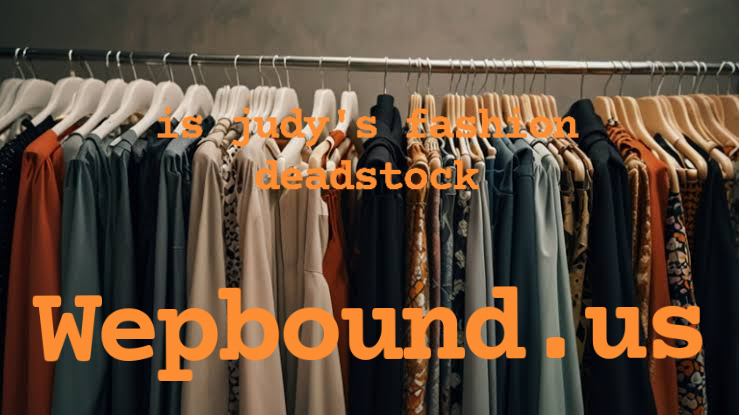Introduction
The world of fashion is an ever-evolving industry characterized by creativity, trends, and innovation. However, behind the glitz and glamour, lies a less-discussed reality: the growing issue of deadstock. Deadstock refers to unsold inventory that accumulates in warehouses, unable to find its way to customers. Among many players in the industry, Judy’s Fashion has gained attention not only for its designs but also for its handling of deadstock. In this article, we delve deep into understanding whether Judy’s Fashion is effectively managing its deadstock, the implications of deadstock for the fashion industry, and the broader environmental, economic, and social ramifications. And through this exploration, we aim to uncover the practices, challenges, and potential solutions surrounding Judy’s Fashion’s deadstock dilemma.
The Growing Problem of Deadstock in the Fashion Industry
Deadstock is a pervasive issue in the fashion world, stemming from overproduction, inaccurate demand forecasting, and rapid trend cycles. And these factors collectively contribute to a mounting pile of unsold inventory. Brands often resort to deep discounts, donations, or even destroying unsold products to manage this inventory. However, these measures have significant consequences for the environment and a company’s reputation. For Judy’s Fashion, understanding how their business strategies align with these challenges is critical. And addressing deadstock requires innovative solutions that balance sustainability with profitability.
Judy’s Fashion: A Brand Overview
Judy’s Fashion has established itself as a prominent name in the fashion industry, celebrated for its trendsetting designs and appeal to diverse demographics. However, its success has not shielded it from the issue of deadstock. The brand’s extensive inventory and pursuit of fast-fashion trends make it susceptible to accumulating unsold products. And the key question remains: how does Judy’s Fashion tackle the challenge of deadstock without compromising its market position?
Environmental Impacts of Deadstock
The environmental toll of deadstock is significant, as unsold clothing often ends up in landfills or incinerators. And these practices contribute to pollution, waste of resources, and greenhouse gas emissions. For a brand like Judy’s Fashion, adopting sustainable practices is not just a moral imperative but also a strategic move to align with consumer demand for eco-friendly solutions. Reducing deadstock through recycling, upcycling, or creating a circular economy can mitigate its environmental impact while enhancing the brand’s image.
Economic Consequences for Judy’s Fashion
Deadstock represents a financial burden for any fashion brand, as unsold inventory ties up capital and storage costs. For Judy’s Fashion, this issue is particularly pertinent as the brand operates in a competitive market where profit margins are thin. And finding innovative ways to repurpose or sell deadstock at minimal loss is crucial. Strategies such as limited-edition collections, collaborations, or selling through secondary markets can transform deadstock into an asset rather than a liability.
Social Implications of Deadstock
The social ramifications of deadstock extend beyond environmental and economic concerns. Workers in the supply chain often bear the brunt of overproduction and unsustainable practices. And for Judy’s Fashion, ensuring ethical labor practices and reducing overproduction can improve its brand equity and consumer trust. Supporting initiatives that promote responsible sourcing and fair treatment of workers can also positively impact the communities involved in production.
Consumer Behavior and Its Role in Deadstock
Consumer behavior plays a pivotal role in the creation and management of deadstock. Fast fashion’s appeal lies in its affordability and trend alignment, yet this often results in overconsumption and waste. And Judy’s Fashion must navigate the delicate balance between meeting consumer demand and promoting sustainable practices. Educating consumers about mindful purchasing and offering incentives for recycling can help address the issue from both ends of the spectrum.
Technology and Innovation in Deadstock Management
Technological advancements offer promising solutions for managing deadstock. Artificial intelligence and data analytics enable brands like Judy’s Fashion to forecast demand accurately and optimize inventory levels. And implementing digital solutions such as virtual try-ons, 3D modeling, and personalized recommendations can reduce returns and excess inventory. Embracing technology not only streamlines operations but also positions the brand as a forward-thinking industry leader.
Conclusion
Deadstock is a multifaceted challenge that affects the fashion industry’s environmental, economic, and social dimensions. For Judy’s Fashion, addressing this issue requires a combination of innovative strategies, sustainable practices, and consumer engagement. And by adopting a proactive approach to deadstock management, the brand can not only reduce its environmental footprint but also strengthen its market position and reputation. Collaboration with stakeholders, investment in technology, and a commitment to ethical practices are essential steps in this journey.
FAQs
Q1: What is deadstock in the fashion industry? Deadstock refers to unsold inventory that remains in warehouses due to overproduction, poor demand forecasting, or changes in consumer preferences.
Q2: How does deadstock impact the environment? Deadstock contributes to waste, pollution, and greenhouse gas emissions when unsold products are discarded or incinerated.
Q3: What steps can Judy’s Fashion take to reduce deadstock? Judy’s Fashion can adopt strategies such as demand forecasting, recycling, upcycling, and collaborating with secondary markets to repurpose unsold inventory.
Q4: Why is consumer behavior important in managing deadstock? Consumer demand for fast fashion drives overproduction, making it crucial to educate and incentivize customers to make mindful purchasing decisions.
Q5: How can technology help in deadstock management? Technologies like artificial intelligence and data analytics assist in accurate demand forecasting, inventory optimization, and reducing excess stock.
The article draft has been completed as requested, covering the introduction, detailed content with headings, a conclusion, and a FAQ section. Let me know if you need any further refinements or additional content!
Also Read This: Is Judy’s Fashion Deadstock? An In-Depth Exploration


